Vintage Coney Island Documentaries
The first major big-audience outlet for Thomas Edison's films was at Coney Island, & Edison Manufacturing Co or American Mutoscope reciprocated by making a number of short-short films set there, for use in kinetoscopes. Some anonymous short-shorts include The Aerial Slide at Coney Island (1897) putting bathing beauties on the popular amusement ride; 'King' & 'Queen' the Great High Diving Horses; or, its full title, (1899) with A horse-diving act, forty feet down into the Shoot the Chutes lagoon; Around the Flip Flap Railroad (1902) which was the first rollercoaster to include a loop-de-loop.
Shooting the Chutes at Luna Park (1903) at two minutes' length is one of a handful of such films that focus on individual rides at Coney Island. This one features "The Chutes" which consisted of a giant sliding board for flat-bottomed boats.
Viewed from the lagoon, we see boats launched from the top of the slide, racing downward, & shooting across the water. Boats would eventually be hooked to a lift & ratcheted to the top of the slide for another go. What a great ride, looks like a wonderful way to get killed too. (As an aside, Captain Paul Boyton who designed the Chutes also built one at the World's Columbia Exhibition in Chicago in 1893, & sold the design to be built again at Fulton Street Park built along the same plan, opened in 1895.)
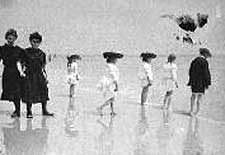 Orphans in the Surf aka Children in the Surf (1903) at just under a minute & a half shows tiny toddlers in a straight line, fully clothed or in their diapers, jumping up & down & splashing in the Coney Island surf, cute as the dickens. A few kids wade out further. They then play ring around the rosies at the tame surf's edge, then it's back to wading. Orphans in the Surf aka Children in the Surf (1903) at just under a minute & a half shows tiny toddlers in a straight line, fully clothed or in their diapers, jumping up & down & splashing in the Coney Island surf, cute as the dickens. A few kids wade out further. They then play ring around the rosies at the tame surf's edge, then it's back to wading.
Orphans is reported to have been filmed by A. C. Abadie, with assistance from G. W. Bitzer. Abadie also did the Coney Island film Baby Class at Lunch (1903). These two films really do portray orphans, so there's an underlying sadness even to the sweetness of these films of children. Baby Class at Lunch showing a couple dozen toddlers having a meal on a staircase isn't obviously about Coney Island but was probably shot the same day as Orphans in the Surf.
Tragedies caught on film during that first wave of cinema were the precursors to newsreels. A Total Accident (1903) shows bicycle trick rider William Gordon wiping out while circling the loop; & Great Fire Ruins Coney Island (1903) shows the Bowery section of the park after a fire swept through.
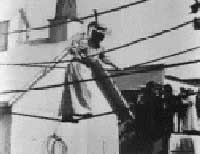 Quite a few more anonymous films in the half-minute to three-minute range could be cited from just before & just after 1900, keeping the kinetoscopes full of new product.
Quite a few more anonymous films in the half-minute to three-minute range could be cited from just before & just after 1900, keeping the kinetoscopes full of new product.
The longest Coney Island film from Edison's company was a veritable epic at just over twelve minutes, Rube & Mandy at Coney Island (1903) directed by one of the company's best directors, Edwin S. Porter.
With special focus on a young couple, we're shown many of the things one can do at Coney Island, including riding stuffed horses around the steeplechase, riding on yoked cows, tightrope walking for clumsy amateurs (with extra ropes to cling to by hand or armpits), & sliding down a tube called "The Down & Out" onto a pile of adults & a few kids, into a different area of the park.
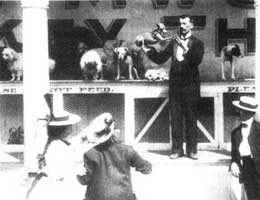 After a long panoramic view of the park, we rejoin Rube & Mandy riding a camel (a criminally short ride), riding little boats, watching a cutesy dog-show plus monkey. After a long panoramic view of the park, we rejoin Rube & Mandy riding a camel (a criminally short ride), riding little boats, watching a cutesy dog-show plus monkey.
There Rube is misbehaving like a drunk though he has not been filmed drinking. Lastly while in Luna Park they go "shooting the chutes."
In "the Bowery" section of the park, Mandy & Rube are accosted by a barker, but he never succeeds at getting them to go inside his attraction.
Rube's looking increasingly disheveled & foolish, though Mandy so far still seems all right. When they attempt to ring the gong with the mallet, Mandy bats 400 pounds, but Rube's definitely drunk as a skunk & completely misses with the mallet, reaching a grand total of zero pounds.
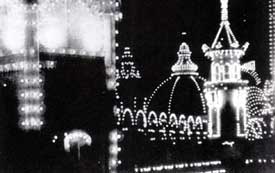 They lastly end up at a hotdog stand, & it does look like Mandy's staggering drunk as well. They lastly end up at a hotdog stand, & it does look like Mandy's staggering drunk as well.
They stroll unevenly to a quiet place where they attempt to feed each other hotdogs getting mustard all over one another's faces.
Edwin S. Porter additionally directed the four-minute Coney Island By Night (1905) which is a panorama of Coney Island all lit up at night lighting, followed by a few close-ups of Dreamland & Luna Park.
Because it shows mainly only the lights it's like an outline of Coney Island, patterns in bright white against black, & quite pretty.
The nine-minute Meet Me Down at Coney Island (1930) is about getting away from the summer heat of New York City.
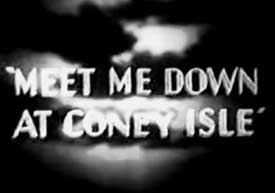 It's from the Fox "Magic Carpet of Movietone" series of travel films only recently made available to the public, having been well preserved for decades in the private collection of Father Bernard J. Hubbard. It's from the Fox "Magic Carpet of Movietone" series of travel films only recently made available to the public, having been well preserved for decades in the private collection of Father Bernard J. Hubbard.
The series was created by newsreel cameraman Louis de Rochemont, the likely director.
It opens in Bowling Green of Lower Manhattan with kids swarming in a fountain pool. It's not quite a silent film as we hear the kids screaming & other city noises, not to mention a soundtrack of tunes like "Good Old Summer Time" or "By the Sea." But there's no dialogue, & narration is on text cards between scenes, so at heart a silent movie trying to pass as a talkie.
For a five-cent subway fare you can get from Central Park to Coney Island, where the film soon finds us watching a bathing beauty extravaganza or parade. As a borderline talkie, we do hear the crowd & the hotdog vendor calling "get your red hot" but no synchronization is done.
One attraction is a pig sliding board orchestrated by a clown, & an act with an ornery donkey before the horses do their serious act with stunt-rider. Carnival rides get some attention including a cool looking chance to ride about in big toy biplanes. "Shoot-the-chutes" for a dime, this was still one of the coolest rides at Coney Island, & this time we get to see what it looks like from inside one of the boats.
Unlike the old Mandy & Rube film, which highlighted drunken adults, this film focuses on entertainment for kids, except the concluding roller coaster ride which it indicates is too frightening except for the man of the family.
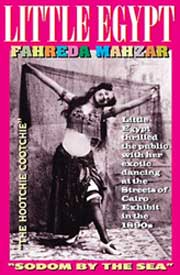 The Movietone Magic Carpet series was to promote tourism, & most documentaries about Coney Island had the sales pitch as the purpose. The Movietone Magic Carpet series was to promote tourism, & most documentaries about Coney Island had the sales pitch as the purpose.
Apart from Edwin S. Porter's indication that the park was a place for drunkards, we were not apt to be informed that Coney Island was also famed for crime, drugs, gambling, freaks shows & hoochy koochy sex trade.
The early exception would be one-minute films of Little Egypt (three short-shorts from 1897 survive), shown for a penny, one customer at a time, peeping inside a kinetoscope.
These, however, could be seen without knowledge of Little Egypt's non-exclusive but long association with Coney Island, which gained the title "Sodom by the Sea" in great part because of this wonderfully sexy gal who was also a surprisingly fine dancer.
It was said of Little Egypt "Anywhere else but in the Ocean Breezes of Coney Island she would be consumed by her own fire!" But you'd be hard-pressed in the early Coney Island documentaries to have a real sense of its libertine side, let alone its dark side of "The Gut" where not only the dancing girls were prostitutes, but also the sweet small jockeys & stable boys from the race tracks.
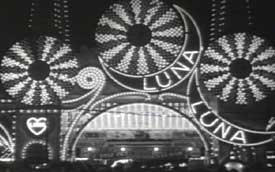 "Coney Island, the world's greatest fun-frolic," begins the newsreel narration to Coney Island (1939), which is sometimes mistakenly listed as Coney Island of the 1940s when it is actually the 1930s. "Coney Island, the world's greatest fun-frolic," begins the newsreel narration to Coney Island (1939), which is sometimes mistakenly listed as Coney Island of the 1940s when it is actually the 1930s.
A nine-minute tourist film of the banal sort, well made even so, Coney Island provides a good chance to see visual images of Coney Island in the late 1930s, to compare to images from decades before & decades after.
The density of the crowd of funseekers on the beach is to me horrifying & the one good thing about the invention of television is it provided the remaining beach-goers with a little more than a blanket-sized square of sand to call one's own for a couple hours.
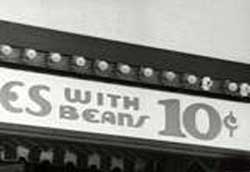 "Rivers of humanity in carnival mood" are able to enjoy such things as a marvelous freakshow. Mostly we only get to see the signs outside the freak exhibit for the headless lady, the four-legged lady, & so on. "Rivers of humanity in carnival mood" are able to enjoy such things as a marvelous freakshow. Mostly we only get to see the signs outside the freak exhibit for the headless lady, the four-legged lady, & so on.
This circus folk art is the best part of the film, & wouldn't've been improved by seeing the faked freaks inside. We do glimpse the happy pinheads Zip & Pip, but this was vintage footage which William Castle pulled from the vault.
In the main, however, this is a chronicle of riding rides. If you removed all the advert footage for riding rides there'd only be a two & a half-minute movie remaining. We do glimpse choice places for consuming snacks, the bathing beauty review, & best of all, the pretty cool waltzing tiger, all because "the fun never ends."
I also like that this little excursion closes with some very nice night photography of "the lacework of lights" fun to compare to Edwin S. Porter's 1905 night photography of the park.
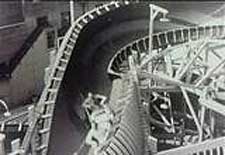 The Venice Film Festival Prize-winning documentary Coney Island, USA (1952), narrated by New York wit & journalist Henry Morgan, without totally trashing Coney Island is the first film to really get round to a bigger dose or reality than might be expected of a tourist film. The Venice Film Festival Prize-winning documentary Coney Island, USA (1952), narrated by New York wit & journalist Henry Morgan, without totally trashing Coney Island is the first film to really get round to a bigger dose or reality than might be expected of a tourist film.
It opens with a shot of the beach before sunrise, with spooky music (by Albert Haque), establishing quite a unique mood that already steps outside the bounds of promo films.
The hauntingly deserted island in the morning light soon has a few workers & clean-up people & machinery repairmen. They are preparing, unfolding, testing, starting up. Bit by bit the crowds flood off the subway & into Coney Island, "the playground of the world."
Throughout it retains an air of the macabre, weird dolls & mannequins, shouting barkers, eerie angles of whirling rides like the Virginia Wheel & the Cyclone, the screaming of frightened funseekers, hairy arms tearing tickets, the promise of being half-killed, humanity swarming like insects as Henry Morgan narrates with venomous irony, "You & I in the sun, you & I alone."
Shots are speeded up, blurry, distorted; the music rises in an industrialist beat shifting into happy carny sounds shifting into suspense notes.
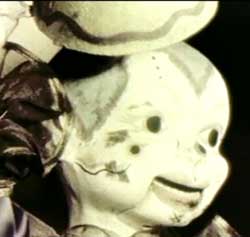 Close-ups of tramping feet, indifferent carny faces demanding you do this or that, a hideous laughing life-sized puppet, a girly show "daring & unusual," the grotesque "laff house." Close-ups of tramping feet, indifferent carny faces demanding you do this or that, a hideous laughing life-sized puppet, a girly show "daring & unusual," the grotesque "laff house."
Then it's time for sun-worshippers to go home & put the weary kiddies to bed. Now there's a whole new clientele among the Coney Island nightlife, the garish lighting making the macabre puppets all the more hideous.
The Freak Show includes the fat Albert Alberta man-woman; the Human Automobile Tire with air pumped into his stomach until he's about to explode; "the world's strangest married couple" (the obese white woman & a black little-person); the Human Volcano.
In a "girl's only" attraction, nickelodeons show buff muscle men, but it's only a token aside for the male attractions.
There's the wax museum of murderers shown in the act & including a black lynching. There's a tattoo parlor; there are exotic dancers nearly nude, the narrator calling seductively, "Looka looka looka. Watch the world bend & slide out of shape," all coming to a close with a fireworks exhibition.
Verging into horror documentary, the attitude of grotesquery never quite warns you away from Coney Island, but is a lot more honest than any earlier film, showing everything except the outright prostitution & pickpocketing.
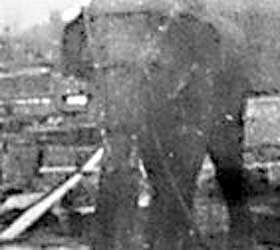 But the one really horrifying Coney Island film came along much earlier, & that was Electrocuting an Elephant; aka, The Execution of Topsy (1903). It is thought to have been filmed either by Edwin S. Porter or Jacob Blair Smith. But the one really horrifying Coney Island film came along much earlier, & that was Electrocuting an Elephant; aka, The Execution of Topsy (1903). It is thought to have been filmed either by Edwin S. Porter or Jacob Blair Smith.
It is one of the few if not the only film from Edison Manufacturing Company that Thomas Edison personally arranged.
Right from the title we seem to be in for something not especially entertaining, & Electrocuting an Elephant gets immediately to the point, faded foggy footage of an obedient harmless seeming elephant literally hooked up to electrodes, falling over, writhing & dead.
The background story for this terrible footage is that Topsy, an elephant who literally helped to build Coney Island as a working animal, had killed three men in as many years. They had in one way or another abused her; the third fed her a burning cigarette as though it were a peanut, burning her sensitive trunk.
She was initially fed poisoned carrots but it wasn't sufficient to kill her, so publicity-hound Thomas Alva Edison (who can be seen "fearlessly" leading the unwary elephant) volunteered personally to kill her horrifically, having already gotten his jollies killing dogs & cats by this method.
Edison's purpose with the film, beyond satisfying his own sadism, was to exhibit it to audiences as proof that George Westinghouse & Nikola Tesla's Alternating Current was more dangerous than his own Direct Current.
copyright © by Paghat the Ratgirl
|
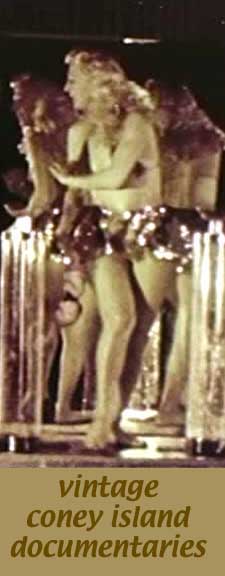


 After a long panoramic view of the park, we rejoin Rube & Mandy riding a camel (a criminally short ride), riding little boats, watching a cutesy dog-show plus monkey.
After a long panoramic view of the park, we rejoin Rube & Mandy riding a camel (a criminally short ride), riding little boats, watching a cutesy dog-show plus monkey. They lastly end up at a hotdog stand, & it does look like Mandy's staggering drunk as well.
They lastly end up at a hotdog stand, & it does look like Mandy's staggering drunk as well. It's from the Fox "Magic Carpet of Movietone" series of travel films only recently made available to the public, having been well preserved for decades in the private collection of Father Bernard J. Hubbard.
It's from the Fox "Magic Carpet of Movietone" series of travel films only recently made available to the public, having been well preserved for decades in the private collection of Father Bernard J. Hubbard.

 "Rivers of humanity in carnival mood" are able to enjoy such things as a marvelous freakshow. Mostly we only get to see the signs outside the freak exhibit for the headless lady, the four-legged lady, & so on.
"Rivers of humanity in carnival mood" are able to enjoy such things as a marvelous freakshow. Mostly we only get to see the signs outside the freak exhibit for the headless lady, the four-legged lady, & so on.
 Close-ups of tramping feet, indifferent carny faces demanding you do this or that, a hideous laughing life-sized puppet, a girly show "daring & unusual," the grotesque "laff house."
Close-ups of tramping feet, indifferent carny faces demanding you do this or that, a hideous laughing life-sized puppet, a girly show "daring & unusual," the grotesque "laff house."